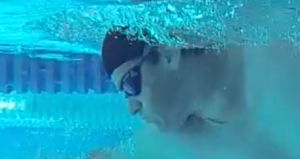You can run forever…
Your bike fitness is exceptional…
But each lap of the pool leaves you gasping for air like Houdini after a breath hold.
Have you ever wondered why this happens even though you’re a fit person?
There’s three main reasons this happens:
- if you hold your breath
- if your body position and balance is incorrect
- if you’re panicked or have tension through stroke
Holding your breath

Just like when you go for a run and hold your breath for 5 or 6 seconds, you’ll be panting and gasping for air even though you are not in the water! The same thing goes when you’re swimming.
If you’re holding your breathe instead of gradually exhaling through the stroke, you still have air in your lungs when you go to breathe. You need to have empty lungs to get a full breath and get fresh oxygen in.
One of the first things to consider when swimming breathing naturally like you’re walking down the street. Inhale and gradual exhale.
Incorrect body position and balance

When your legs are sinking you have to work harder to stay afloat in the water. If you’re horizontal to the surface and are well-balanced in the water, you can relax. Then you can put your effort into propelling yourself forward, not keeping afloat.
One of the main things to focus on to be balanced is where you feel your weight when you’re swimming.
You want to feel you weight through your chest, a little bit through your neck and through your head as well. That should be pressing down in the water to help bring your legs up. Where you feel your weight in swimming is really important to feel balanced.
Feeling panicked or having tension through your stroke
To swim faster you have to stay relaxed as you do it. Relax doesn’t mean sloppy swimming. It means not being rigid or tense through your stroke.
In order to do that, it helps to get the first two things right:
- gradually exhaling through the stroke
- having your body position and balance right
After that, it’s a lot easier to get rid of any tension or rigidity through your stroke. That way, you can make sure that you are not running out of breath at the end of each stroke.
If this makes sense to you you’re ready to join Effortless Swimming membership, an online coaching program for triathletes, open water swimmers and pool swimmers. Using the Effortless Swimming coaching system you can increase your speed through better technique and swim skills.



I’ve been trying to fix my body position in the water for years! …….with little to no success
Hi Gerry, we’ll be covering that in an upcoming post.
Great comments there coach. I’m really happy with the progress I’ve made since the last clinic. The video was a real ‘aha’ moment and I could see immediately what I needed to fix. Training times have been much quicker this week and the stroke MUCH better. Thanks AGAIN 🙂 Paul
Hi
How do you press your upper body down the water to get your legs up?
JP
Natural street-walking breathing is not exhaling all the way (Physiologists refer to this as “tidal volume”). Tidal volume is a normal breath with room to both inhale and exhale MORE. Shortness-of breath is most related to accumulating carbon dioxide (CO2) more so than oxygen deprivation (which is hard to do, actually). When swimming, I solved a big part of the out-of-breath problem by training to exhale FULLY and inhaling FULLY on each breath cycle. This way you can [almost] empty your lungs of CO2 on each breath as you exhale, and maximize O2 intake with each max. capacity inhalation. It takes some work………………